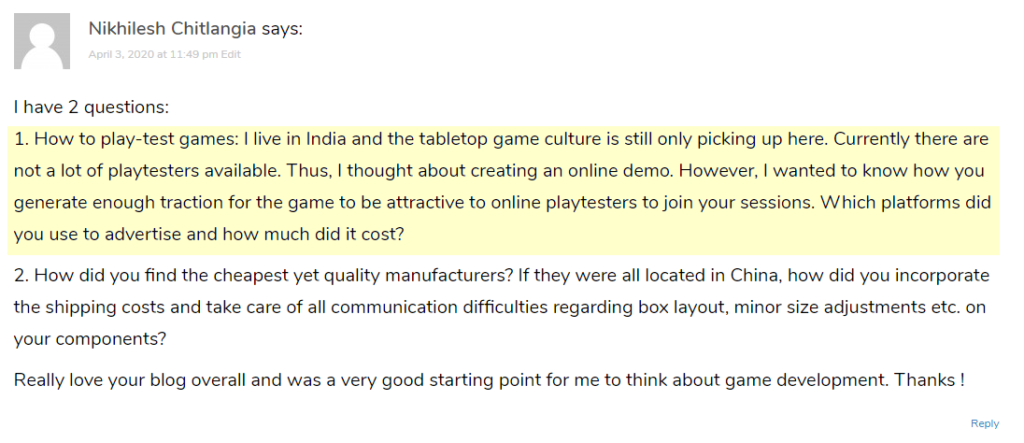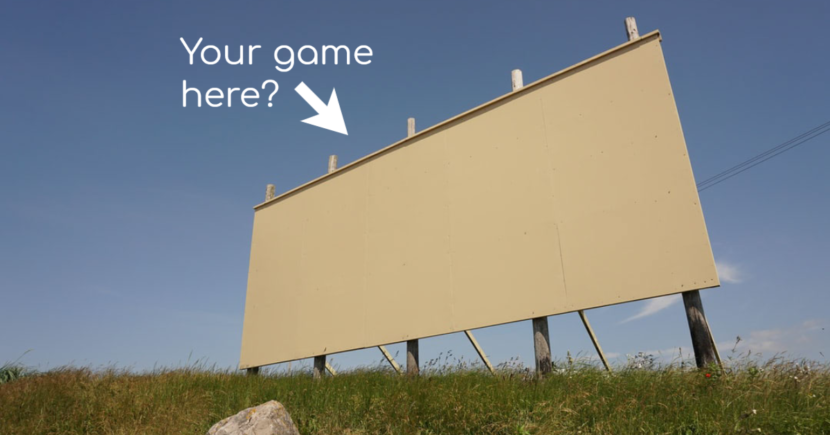A couple of months ago, I asked the readers of this blog to send in answers to the question “what confuses you most about board game development?” I got a lot of responses, and one of them was about how much to spend on board game advertising. That’s what I’ll be talking about in this post.
Need help on your board game?
Looking for more resources to help you on your board game design journey?
This week, I want to respond to a comment by Nikhilesh Chitlangia. I want to particularly focus on part one, which can be roughly summarized as, “how much should I spend on advertising for my board game?”

This is a tricky question for two reasons:
- It presupposes that you have adequate funds to advertise in the first place, which is not true for many creators.
- It also presupposes that you have the ability to create an ad that leads to sales, which is also a pretty big assumption.
For the sake of the rest of this post, we’re going to assume both are true. That is, we’re assuming you have the money needed to bankroll your game and you have a decent understanding of how to make a good ad.
Basics of Board Game Advertising
Let’s go over some of the basics of board game advertising before we start talking hard numbers. First, board game advertising is primarily online. I cannot readily think of any print publications or other traditional media that would provide a suitable outlet for advertising products in such a niche market.
With this in mind, there are five basic ways to advertise your board game online:
- Board Game Geek
- Paid previews
That last one might come across as odd, but I’ve included it because I believe that Pinterest is a generally underrated website for advertising to niche audiences. Advertising pins blend in really well on boards.
With previews, you want to make sure you pay someone with a large audience who likes games like yours. From there, they will handle the rest. All you have to do is share the video when it’s done.
As for the other advertising channels, you must follow these basic principles:
- With everything but Board Game Geek, make sure you target only people who like board games. If you can narrow down your audience further from there, that’s even better.
- You need a great picture of either the game box or the game being played. You might experiment with videos as well.
- When additional text is required, as with Facebook, Instagram, or Pinterest, a simple, straightforward description of the game goes a long way. We got a really good response with the following copy for Tasty Humans: “Become a monster. Eat villagers. A puzzle-solving, tile placement board game for 1-4 players.”
Metrics for Ad Spending
When you start advertising, you will likely be inundated with acronyms and jargon. A lot of people obsess over CPC (cost per click) or impressions (number of ad views). Those are important, but they’re not the most important, at least not strategically.
Three metrics matter more than everything else. They are ROAS, CAC, and LTV.
ROAS is return on ad spending. You can calculate by dividing the amount of revenue an ad campaign makes by the amount you spend on it. According to BigCommerce, an ROAS of 4 is good. You can grow a business on 3, though many other businesses require 10 or more.
Personally, when it comes to board games, I shoot for a ROAS of 5. I like to spend $5 on ads for every $25 I get on a game.
CAC is customer acquisition cost. That is how much you pay to get a brand new person who has never bought from you to buy from you for the first time.
LTV is lifetime customer value. That is how much the average customer spends on your business once they become a customer.
LTV and CAC are often used together. You generally want the LTV of a customer to be three times the CAC. This is a relatively lofty goal, but one I think you should strive for as much as possible.
What’s important about all the metrics above is that you want to watch the amount of revenue your ads are bringing in, not necessarily the cost per click. If it takes 50 clicks to get a sale, but the cost-per-click is $0.10, then it costs $5 to make a sale. If your cost-per-click is $1.00 but a fifth of clicks buy your game, then it also costs $5 to make a sale.
(That said, if you really need a CPC number, I shoot for $0.20-0.30 on Facebook with 1-in-20 making a purchase.)
How Much You Should Spend on Board Game Advertising
As I see it, there are two different methods you can use to determine how much money to spend on board game advertising.
1. The “How Much Money Can I Afford to Lose” Method
Believe it or not, this is the method I used with the Tasty Humans Kickstarter. My team and I collectively spent around $2,500 in marketing and ended up gaining around $28,000 between Kickstarter and BackerKit in return. We figured we might be able to raise $15,000-18,000 at our level of marketing spending, but the game exceeded our expectations.
We chose the $2,500 figure simply because that’s the amount we were willing to spend and because we would not feel bad if we underperformed.
This method has its shortcomings, though. You pretty much have to be willing to spend at least $1,000 to get a decent amount of attention with advertising. You can’t expect magic to happen without spending a substantial amount of money.
2. The Desired Revenue Method
Let’s say that you have a great abundance of capital available to you right now. Instead of your limitations being set by the amount you are willing to lose, they are set by what you desire to gain.
In this case, if you want to make a certain amount of revenue, then to determine your advertising budget, you can divide the revenue you want by your expected ROAS. That is to say, if you want to make $50,000 and expect an ROAS of 5, then you should spend $10,000 on advertising.
This method is pretty handy, but be careful. Advertising spending can have diminishing returns if you spend a truly enormous amount on it. Furthermore, there is no guarantee that you will receive the ROAS for which you are hoping.
Advertising is Not the Only Way to Generate Leads
For all this talk of advertising, I want to make something clear. You can either market with time or with money. Advertising is very expensive in terms of money, but not so bad in terms of time. I love ads because they are simple and allow me to continue with other aspects of my busy life. They are not, however, a silver bullet. You need to generate leads (that is, potential new customers) in other ways.
First and foremost, your game needs to be great. This goes without saying, but I’m still saying it because it’s that important! If your game isn’t great for a specific group of gamers, no ad will save you. Likewise, if it is truly great, your odds of getting word-of-mouth or “being discovered” are dramatically increased.
Content marketing is a great way to spread the word about your game. That includes writing blog posts, using social media, live-streaming the game, showing up on podcasts, and so on. The point is: give people something to consume and it will help spread the word of your game and your brand.
Reviews are tremendous at establishing trust and are relatively low-cost, often only costing the price of a prototype and shipping. You need some amount of reviews for people to take you seriously and buy in the first place. Beyond the fifth or sixth review, though, additional reviews serve primarily as a way to be mentioned in front of others on their media channels, thereby generating leads.
Play-testing with others and generally networking – online or offline – is a way to generate leads, too. Just make sure you don’t come across as too salesy. Be genuine, try to have a good time, and help them with what they need help with as well.
Lastly, making in-roads with board game distributors is also a good way to market your game. Not only will they buy your game outright sometimes, but they will also shelve it online or offline in ways that people are likely to see.
Final Thoughts
There is no hard and fast rule on how much you should spend on board game advertising. All marketing efforts should be examined in terms of how much revenue they bring in. Once you confirm that your advertisements are bringing in enough money, then your spending should be determined based on either how much you can spend or how much you want to make!






One thought on “How Much You Should Spend on Board Game Advertising”
This was really useful thank you, I find there’s not always enough hard numbers about these kind of things!